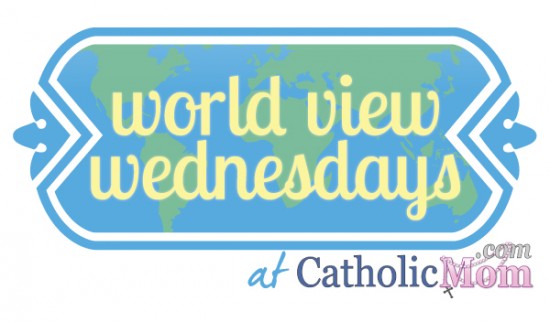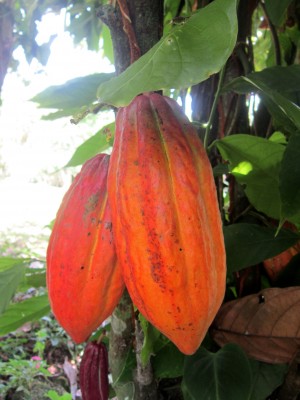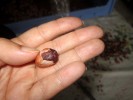“A way has to be found to enable everyone to benefit from the fruits of the earth, and not simply to close the gap between the affluent and those who must be satisfied with the crumbs falling from the table, but above all to satisfy the demands of justice, fairness and respect for every human being.” (Pope Francis, Address to the Food and Agricultural Organization, June 2013).
Chocolate comes from a plant called the food of the gods (theobroma cocoa). A few years ago mom sent me a whole box of Divine Chocolate candy bars. She said that it is called divine because was being sold at her parish to support Cocoa farmers. I wasn’t sure, I was cautious. What makes this chocolate different? Is it still tasty? Do farmers really get support? My mom never sends that much chocolate without a good reason.
Divine Chocolate is very tasty—after a whole box of it I should know (yes, I did share it with the other sisters. My mom still checked up on me in this regard). I want to know why it is different and make sure that farmers really are being supported by my mom’s purchase. As I write this article I’m also wondering if there is a need to promote the purchase of Fair Trade Chocolate exclusively.
When I tweeted the fact that twelve thousand children work as slaves on cocoa farms there was a lot of interest shown by the number re-tweets I received. This was no longer just about the health benefits of dark chocolate.
My research began at the community lunch table when I shared with the sisters what I was learning. How providential that Sr. Marlyn Evangelina sat next to me! Her family has a Cocoa farm in Costa Rica. She helped me to envision the way Cocoa looks. Each tree produces about 20 to 30 pods a year. Each pod contains 20 to 50 almond size cocoa beans. About 400 dried beans are required to make one pound of chocolate. She also explained the whole process of making chocolate from Cocoa pod to candy bar. She even had photos. I still wondered why child trafficking and adult slavery is needed to harvest beans.
Most of the world’s cocoa comes from West Africa with 82% of the world harvest located in the Ivory Coast. Cocoa is grown on plantations that are family owned. Farmers barely make a living selling the beans and often resort to the use of child labor in order to keep their prices competitive. Pods are harvested by hand and sliced open using a machete. The children climb the cocoa trees and cut the bean pods using a machete. The pods are packed into sacks and dragged through the forest. Later, holding a pod in their hand, imagine a child swinging a machete down to split it open. Many are injured. Children are also exposed to dangerous pesticides which they spray on the plants with no protection for themselves. Some of these children are sent to work by their families who are in need of money. Others are “sold” by their own relatives to traffickers or to the farm owners. They may be as young as twelve. They don’t see their family for years, if at all. Most of them haven’t even tasted chocolate. They don’t even have a decent meal to eat. By contrast most of the world’s chocolate is consumed in Europe and North America. I pause here to think of Willy Wonka and the Chocolate Factory, one of my favorite children’s books. In this book family is important while riches and consumption do not lead to happiness. Reading that book as a child I didn’t know where chocolate originated or how it was harvested.
It seems the problem starts with lack of education, training and taking action against child labor violations. No, it starts even sooner. The problem begins with poverty. There is a demand for cocoa, the raw ingredient for chocolate, yet family farms are in jeopardy. Without child labor there will be no farms, without farms there will be no cocoa. Nestlé and other candy companies took notice when they realize without sustainability there will be no affordable cocoa within twenty years. Even of more concern to us, no child in West Africa will find the golden ticket of freedom in any candy bar. Nestlé is finally allowing its production chain to be traced and assessed. Mapping its cocoa supply chain allows the chocolate-maker to identify the areas in need, educate workers and take action against child labor violations. Other companies, such as Ferraro and Hershey, have also pledged to eradicate child labor and forced adult labor by 2020.
One of the biggest questions asked after my tweet regarding child laborers on cocoa farms was “what can we do to help?” I am glad that the candy manufacturers are stepping up. I hope that there will be just wages for the workers. Farm owners need money to buy new trees. Companies who process the cocoa get a lot more money for the “added value” product. Some of them are beginning to show concern for the farmers. Still, most money is earned by the candy-makers. The chocolate industry is worth an estimated $110 billion a year. Meanwhile 800,000 children living in poverty travel on muddy roads to get to cocoa farms, drag heavy loads to the next site, work up to ten hours a day, get little nutrition, forgo school to handle dangerous machetes and risk exposure to harmful pesticides, and may be locked up or beaten if they don’t work harder.
What can we do? Share the videos on CNN’s Freedom Project site created to help end all forms of modern day slavery http://thecnnfreedomproject.blogs.cnn.com/; Purchase chocolate with a Fair Trade stamp (The Food is Power website has a list of recommended chocolate to purchase, http://www.foodispower.org/chocolate-list/ ) or purchase it from the following Fair Trade organizations: Catholic Relief Services, which promotes other causes as well, www.crsfairtrade.org/chocolate; give Divine Chocolate to your friends, this chocolate company is owned by cocoa farmers, www.divinechocolate.com; Equal Exchange, a worker cooperative, will support your fundraising initiatives, www.equalexchange.com; Fair Trade USA, a nonprofit organization and leading third-party certifier of Fair Trade products http://fairtradeusa.org has many Fair Trade products.
As of 2005, less than 1% of the chocolate market was Fair Trade. Fair Trade ensures that farmers receive fair prices, allows them to invest in new techniques and strictly prohibits slave and child labor. As Willy Wonka said: “So shines a good deed in a weary world.” Better yet, Pope Francis says: “To love God and neighbor is not something abstract, but profoundly concrete: it means seeing in every person and face of the Lord to be served, to serve him concretely. And you are, dear brothers and sisters, the face of Jesus.” (Pope Francis, Address during Visit at “Dona Di Maria” May 2013).
What do you think? Is it important to promote Fair Trade Chocolate exclusively or can you think of another way to help those enslaved, trafficked, and suffering in this industry?
© 2014 Daughters of St. Paul; Sr. Margaret Kerry, fsp
About the Author

Sr. Margaret Kerry, fsp
A Daughter of St. Paul for 40 years Sr. Margaret continues to pursue new ways to proclaim the Gospel: sharing the Pauline Charism with the laity, writing books (St. Anthony of Padua: Fire & Light; Strength in Darkness: John of the Cross; Prayers for the New Evangelization), & through direct evangelization. She is available for workshops on the Vocation & Mission of the Laity, Media Literacy, and The New Evangelization. mkerry@paulinemedia.com





.png?width=1806&height=731&name=CatholicMom_hcfm_logo1_pos_871c_2728c%20(002).png)
Comments